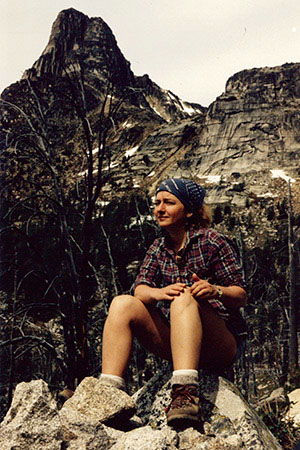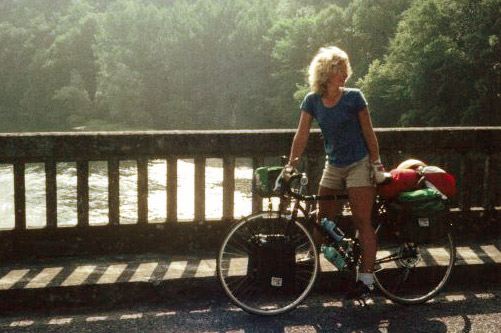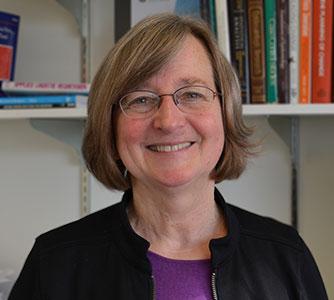What is your vision for the department?
My vision has to have a historical aspect to it, as I’ve been on faculty for 25 years and was a student for five years before that. What’s always impressed me is the quality of teaching, particularly epi methods, as well as the quality of research. My vision is to help make those activities sustainable in a changing educational and research environment (she cites reduced state aid and a drop in federal grant support) and to extend our activities to some new avenues.
What new avenues?
Victoria Holt on the efficacy of oral contraceptives in heavy women
Historically, we’ve focused on our graduate programs, but we’re looking at expanding our undergraduate offerings. Increasingly, there’s a recognition that undergraduate public health programs are an important aspect to schools of public health and public health training in general.
Another avenue is distance learning or online courses, which is something we’ve not emphasized in the past but is increasingly important.
I’d also like to increase our educational offerings in epidemiology for public health practice. Historically, our master’s students have been interested in doing clinical or general epi research. With the advent of the public health major, we’ll see more people with different career goals, including positions in public health agencies.

Victoria Holt hiking in the Sierra Nevada
Do you have any strategies to address the drop in NIH funding?
It’s a challenge. We’ve started a Research Strategies Group – junior faculty are collaborating with senior faculty who have had success with large grants. The goal is to make more effective proposals before that first submission. One of the most rewarding parts of the job so far has been my interactions with junior faculty. The enthusiasm and passion they bring to the job is wonderful to see.
What research are you most proud of?
We did a landmark study on intimate partner violence funded by the NIH and the CDC. We looked at women who experienced violence in Seattle and had reported it to police or sought a protection order. We looked forward for a year and found that women who got permanent protection orders were less likely to experience physical abuse (though not less verbal abuse). It was one of the first population-based studies that could look at women who didn’t get protection orders as a comparison group.
What research was the most fun to work on?
Highlights
- PhD, Epidemiology, UW, 1990
- MPH, Epidemiology, UW, 1987
- BS, Psychology, UW, 1973
- BSN, Nursing, UW, 1980
One reproductive health study got a lot of play in women’s magazines. The question arose in my mind: What happens to the effectiveness of oral contraceptives in women who are extremely heavy? The dose of estrogen and progesterone had gone down considerably over the previous decades. Might we find ourselves in a situation where the dosages of current pills are no longer sufficient to suppress ovulation and keep extremely heavy women from getting pregnant?
In fact, it was true. Women of a high absolute weight and women of high BMI were more likely to get pregnant while they were using their oral contraceptives. I got a lot of emails from women asking what they should do.
What did you tell them?
Talk to your doctor. I did not tell them to start using a higher-dose pill. Because the other part of the issue with women who are heavy is that they may be more likely to have cardiovascular disease, for which the pill may increase risk. So, add another method to the method you’re using.
How did you make the journey from psychology to nursing to public health?

Hiking through native lupine in Montana
I was a first-generation college student and didn’t have a clear career focus as an undergraduate. I actually dropped out after three years and spent some time doing other things before coming back to finish my degree in psychology at the University of Washington.
I worked at Harborview as a mental health specialist for a few years. One of the things that stays with me was my recognition of how common intimate partner violence was among in-patient mental health patients – typically, women who had attempted suicide.
Then I moved to an island in Maine and eventually decided a career would be nice. There was a visiting nurse there and he seemed to have a good career, so I decided to go back to university to do that.
How long did you live in Maine?
Just for a year. I worked in a fish-packing plant, turning herring into sardines by cutting their heads and tails off. I also had a small business doing wicker chair repair. It was fun, but a lot of work.

Cycling in Europe in the early '80s
What sparked your interest in women’s health and reproductive health?
I practiced as a nurse at Children’s Hospital in the emergency room and also worked with a friend who was a licensed midwife and we did homebirths in Kitsap County. And I think my interest in public health and epidemiology in general came from my experiences in the pediatric emergency room. Seeing kids coming in over and over again with episodes of asthma, I was curious about how that could actually be prevented rather than just treated every time.
At Children’s, I saw a poster for the Maternal and Child Health program at SPH, which had just started. I was in the first class. After my PhD, I joined the MCH as a program faculty member.
What do you do for fun?
I live on Vashon Island on five acres of land, so I do a lot of gardening. I have a vacation house on the coast of Oregon, so that is my passion right now – exploring the northern coast and the mountains of Oregon. I like to play piano – both classical and jazz.
(By Jeff Hodson)
Originally Published: December 2015
